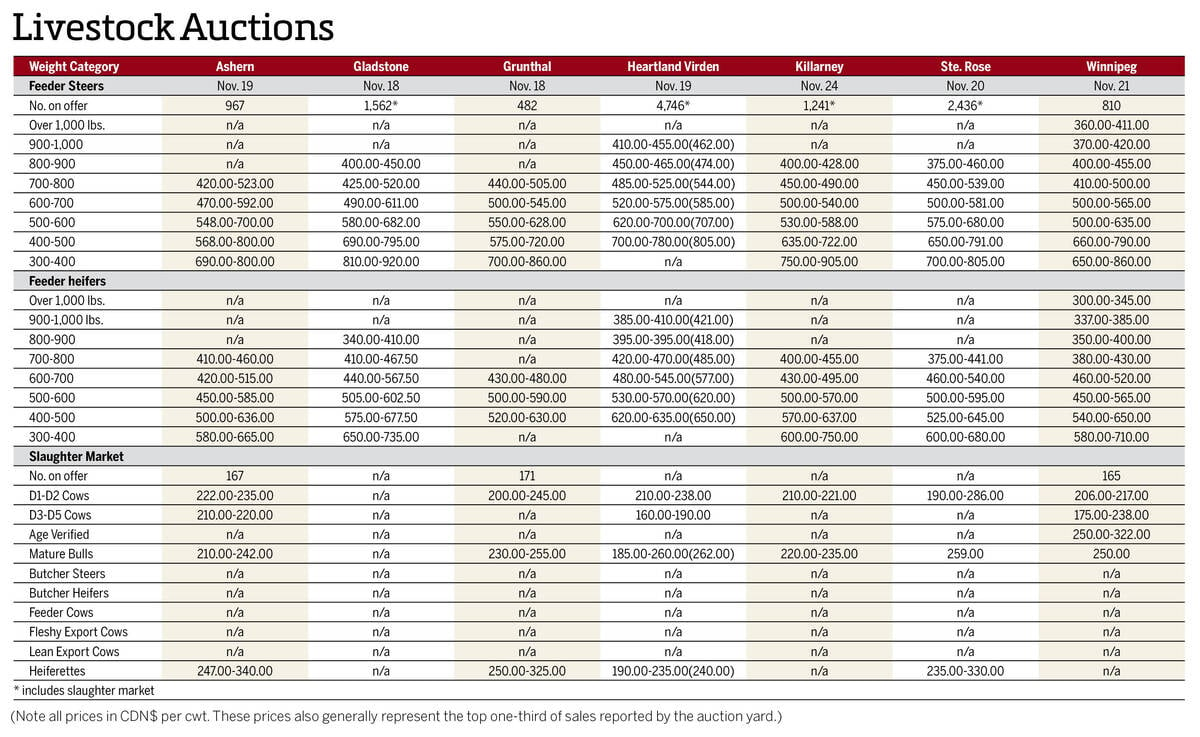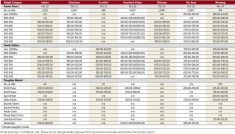[UPDATED: Feb. 23, 2024] Brett McRae is spicing up his corn grazing system this year.
He’s got more than one variety growing – a grazing-oriented option and the typical silage corn – but the real experiment is happening beneath the canopy. This year, the corn shared space with forage soybean and hairy vetch.
The beans were “very impressive,” he said during a late-January tour to his farm south of Brandon. “In the best spots of this field, where there was 10-foot-tall corn, the beans were probably chest height.”
Read Also

Manitoba cattle prices – Nov. 24
Cattle prices from Manitoba’s major auction marts for the week of Nov. 18-24.
Why it matters: Research stations in Manitoba have been experimenting with forage soybean as an intercrop partner with corn, but mostly for silage.
The idea of adding legumes to intercrops for soil health purposes is well established. The hope is that the field will benefit from added nitrogen fixation, along with the purported other benefits of intercropping, such as erosion prevention, green cover and weed suppression.
From a feed standpoint, both soybeans and vetch are high in protein, offsetting the typical weakness in corn, which is famously high in energy but requires supplementation when fed.
In recent years research stations have explored intercropping in terms of corn grazing and improved soil health and to gauge whether the practice could reduce time and cost associated with supplemental hay.

How it started
Forage soybeans are new to intercropping species lists in Manitoba.
The idea of a long-growing species, which would stay vegetative in a northern climate, was interesting to Joe Gardiner, co-founder of forage seed provider Covers & Co. The variety he chose, sourced out of South Carolina, was marketed for grazing and as a tool to improve soil health.
The ensuing trials showed promise. With soybeans added, Gardiner reported 40-50 pounds an acre of residual nitrogen in 30-inch corn rows. His own experiments on 60-inch rows showed even more, although the company’s current recommendation is to stick to narrower spacing to preserve biomass yield.
Forage soybeans were later integrated into plots at the Westman Agricultural Diversification Organization. The southwestern Manitoba research station, known for its intercrop innovation, had turned its attentions to forage corn mixes.
Forage soybeans joined tillage radish, Italian rye grass, crimson clover and hairy vetch in the lineup of corn companion crops. The mix fell prey to drought, grasshoppers and gophers, although organizers plan to try again in 2024.
The species has also been put to work on Manitoba Beef and Forage Initiatives, an applied research farm north of Brandon, said Covers & Co. sales manager Owen Taylor.
“We recommend sowing at 20 pounds per acre, either day before, day after or the same day as the corn planter,” he said. “Most producers will just solid-seed the soybeans, a lot of them, when they put the fertilizer down. Some producers were able to bump the planter over and sow directly between the rows.”
Producers fertilize the corn at regular rates, he added.
The company also urges producers to seed rows north-south to maximize sunlight between the rows.
Corn grazing is untested ground. The company typically sees the mix put to silage, Taylor said, with cows turned out afterward to graze the residue in fall or early winter.
“Probably 60 to 70 per cent of the plant actually ends up in the pile and we’re seeing an increase of 1.5 to two per cent in protein on a feed test. And then what’s left of the beans, guys are grazing it after.”
Producers who corn graze can expect the same soil health, nutrition and water infiltration benefits of intercropping for silage, Taylor said, but it’s unknown how snow load and leaf drop will affect feed quality.
How it’s going
McRae opted for 30-inch corn rows, but backed off the population. His stand was targeted at 24,000 plants per acre, down from the 30,000 he’s done for regular corn grazing.
The soybeans were seeded the day after the corn at the rate recommended by Covers & Co. Hairy vetch was seeded at five pounds an acre.
“I’ve liked it so far,” McRae said of the soybeans. “The beans, I think, are adding a little bit of protein and other minerals to it.”
That’s hard to quantify, he admitted. Feed tests prior to turn out showed an increase in protein and the beans climbed high enough to clear the snowpack, but he doesn’t have a split field set up to directly compare a pure corn system to the intercrop.
“I haven’t really sat there all day and watched them graze through it, but judging by what’s left when they leave the field, they’re eating enough of it that I think they’re getting some benefit,” he said.
Between hairy vetch and soybeans, however, the soybeans are winning. Both the corn and soybeans are glyphosate tolerant, making weed management easy, McRae noted. The vetch was stunted by the herbicide.
“I think that’s a little bit year-to-year dependent,” he said. “I was hoping the vetch would vine its way up the corn so we would be able to access it this time of year in the winter.”
There are few good herbicide options for a corn intercropm other than glyphosate.
“It’s just so hard to put another species into it because all of the corn herbicide is meant to kill everything except corn,” McRae said, adding that there is also the challenge of herbicide residue.
He has had a good winter for the experiment so far, Taylor noted. Snowpack has been light, reducing hurdles for soybean uptake.
Covers and Co. does not have different recommendations for corn intercrop grazing versus intercropping for silage, he said.
*Update: A sentence was changed to highlight the environmental and insect influence on a corn companion crop.
















